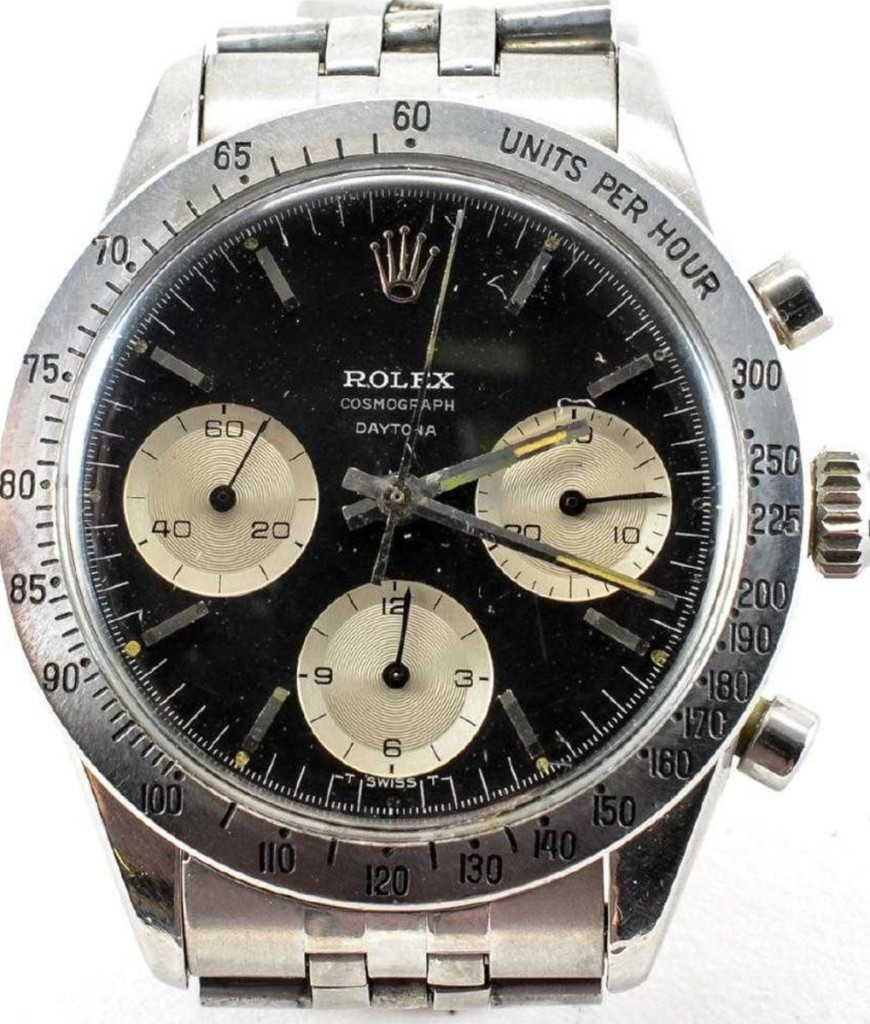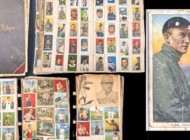
The top lot of the sale was a 1964 men’s Paul Newman Rolex Cosmograph Daytona stainless steel wristwatch, which finished at $56,350. Brechlin believes the surge in pricing for vintage Rolex Daytonas is caused by the long waiting list for new models.
Review and Onsite Photos by Greg Smith
BERLIN, CONN. – Nest Egg Auctions auctioneer Ryan Brechlin posited that his firm had been doing a New Year’s sale for approximately 15 of the house’s 20-some years in business. The approximation because the exact year is a point of scholarly contention at family holiday dinners. Historical record aside, any semblance of blurriness quickly burned off to clarity as a view of more than 60 people filled the hall for Nest Egg’s December 29 sale – the last of seven cataloged auctions in the firm’s 2018 calendar – to try their hand at purchasing from a varied assortment of 348 lots of jewelry, fine art, decorative arts, ephemera, watches and collectibles offered that day.
Reached after the sale, Ryan Brechlin told Antiques and The Arts Weekly that the sale was a good way to cap off 2018 and start the new year. “Boy, some items did fantastic. I was happy with it,” he said. Asked what he felt performed the strongest, he said, “It seems like all they want is watches these days. There are some soft categories in the auction business, but that is not one of them. All the watches are strong.”
Like clockwork, at the top of the sale was a 1964 men’s Paul Newman model Rolex Cosmograph Daytona stainless steel wristwatch, which finished at $56,350. It sold to a Swiss watch broker. The timepiece was set up with a stainless steel bezel and band but came with replacements, including a two-tone stainless and 14K Jubilee bracelet and an official Rolex 14K yellow gold bezel with original tin case. The watch was consigned through its original owner, who bought the piece in the United States in the 60s. “The consignor originally said he wanted to get $10,000 for it,” Brechlin said before the sale got underway. “I said we can definitely do that.” The consignor paid around $400 for the watch at the time of purchase.
Brechlin has a theory on the reason Rolex Daytonas are performing well lately: “The waiting list to get a brand new Daytona is as much as ten or 12 years, and it’s driving the market for vintage models. It also helps that Paul Newman’s actual Daytona sold for a record price in 2017; so the model is coveted. It’s the watch of the moment, and it’s what every collector wants right now, and since they’re not available, they’re going crazy at all levels.”
Finishing in a rare second place, by just a nose, if you will, was an oil on canvas portrait by Franklin Brooke Voss featuring famed racehorse Man O’ War. After a bidding war between four phone bidders, it sold at $55,200 to a private collector. The work represented a sort of tour de force in American equestrian painting. Voss is considered one of the finest American equine painters of the Twentieth Century, having studied under George Bridgman for seven years at the Art Students League of America. Voss was commissioned by some of the Gilded Age’s most wealthy families to paint their thoroughbreds, many of which were renowned race horses. Man O’ War was no different, going 20-1 in his two-year career (1919-20) and going down as one of the greatest racehorses of the Twentieth Century. The work measured 22 by 16 inches and came from a private Connecticut collection.

Auctioneer Ryan Brechlin stands beside an oil on canvas portrait by Franklin Brooke Voss featuring famed racehorse Man O’ War. The portrait sold to a private collector for $55,200.
At $8,050 was a rare volume titled Russia’s Treasure Of Diamonds And Precious Stones, edited by Aleksander Evgenevich Fersman and commissioned by the USSR’s People’s Commissariat of Finances in 1925. The volume documented the crowns, rings, necklaces, earrings and scepters that rulers from the Sixteenth through Twentieth Centuries had acquired, including photographs and descriptions of each. Some of these works were awe-inspiring, including the Great Imperial Crown, which was documented as having been worked on by Genevan diamond jeweler Jérémie Pauzié, the celebrated jeweler of Catherine II, and the court’s jeweler Georg Friedrich Ekart. The crown featured 4,963 stones and 2,858 total carats. It included a 55-23/32 carat octahedral-shaped solitaire diamond that was given to tsarita Elisabeth by her own people as a token of gratitude when taxes on retail shops and booths were abolished by her order. The crown is currently on display in the Moscow Kremlin Armoury’s State Diamond Fund. While the result is notable, the volume has taken a dive in value in the past ten years. In only 2007, the book sold at Christie’s London for nearly $91,000. Subsequent offerings saw results at $20,400, $15,535 and $10,000. Brechlin believes the disparity is due to the book being scanned and becoming available for view online in its entirety.
The sale was attended by a host of jewelry dealers and savvy collectors who all competed for good prices on a wide assortment of jewelry, though watches really dominated the category. At $20,700 was a men’s 1967 large size Le Coultre stainless steel Memovox Polaris Compressor model wristwatch. The diving watch featured a mechanism that would vibrate when it was time to come up for air. A men’s Rolex Day Oyster Perpetual wristwatch brought a good price at $8,625. It featured an 18K gold band and bezel. Selling for $4,140 was a Le Coultre men’s stainless steel case and band Triple Register Chronograph wristwatch with rare 17-millimeter bracelet. At the same price was another Le Coultre, this one a circa 1860s yellow 18K gold Triple Calendar wristwatch.
More than 50 lots in the sale contained silver or were silver themselves. The category was led by a Boston lighthouse cocktail shaker by Meriden Silver Plate Co, which sold at $3,335. The piece was designed in 1927 and this work was made shortly after. It measured 56 ozt. Behind at $2,185 was a case of Wallace Grand Baroque sterling silver flatware with service for 12. An estate sterling silver group finished at $1,035. It was a varied lot with more than 20 pieces from a number of makers, including Tiffany, Durfer, Towle, Wallace and others.
A fascinating little piece of Major League Baseball memorabilia came in the form of a small Gorham silver medallion. The 1896 presentation medal, which allowed entry into any baseball stadium in the league that season, was given to John B Day by John T Brush. Both were owners of the New York Giants in the 1890s, while John B Day was also the owner of the New York Metropolitans and the Polo Grounds Playing Field. The season pass sold for $2,530.
Other paintings caught the attention of bidders. At $16,100 was the fourth highest lot in the sale, a Hudson River School landscape oil on canvas featuring a river scene with trees and a field in the background beneath a colorful sunset. It measured 7 by 15 inches. A very faint M was visible in the bottom right corner, and some were guessing that it may be the work of Jervis McEntee. From a private Connecticut collection came a 24-by-29-inch oil on canvas work from Henry Bacon (1839-1912) titled “The Lost Money, Dresden.” It sold for $2,185 and had provenance to William Vareika Fine Arts.
Objects and decorative arts were led by a cast iron cat face architectural element, which sold at $3,680 above a $500 estimate. A British royal coat of arms carved panel was another surprise, selling at $1,725 over a $500 high estimate. The panel was carved in oak and featured the royal coat of arms atop a group of cannons. It was dated to the Eighteenth or Nineteenth century and the auction house thought it may have been a hatch or door panel from a Royal Navy ship. Finishing at $1,150 was a Roseville Pottery Company vase signed A. Williams featuring a Native American Indian. It stood 10½ inches high.
The firm has a full schedule of sales in 2019, including Premier Firearms in April, a “Made in Meriden” June auction, and a single-owner Mineral collection in August.
All prices reported include buyer’s premium, as reported by the auction house. For more information, 203-630-1400 or www.nesteggauctions.com.





















